
6
English
A moment of inattention while operating power
tools may result in serious personal injury.
b) Use personal protective equipment. Always
wear eye protection.
Protective equipment such as dust mask, non-skid
safety shoes, hard hat, or hearing protection used
for appropriate conditions will reduce personal
injuries.
c) Prevent unintentional starting. Ensure the
switch is in the off position before connecting
to power source and/or battery pack, picking
up or carrying the tool.
Carrying power tools with your fi nger on the switch
or energising power tools that have the switch on
invites accidents.
d) Remove any adjusting key or wrench before
turning the power tool on.
A wrench or a key left attached to a rotating part of
the power tool may result in personal injury.
e) Do not overreach. Keep proper footing and
balance at all times.
This enables better control of the power tool in
unexpected situations.
f) Dress properly. Do not wear loose clothing or
jewellery. Keep your hair, clothing and gloves
away from moving parts.
Loose clothes, jewellery or long hair can be caught
in moving parts.
g) If devices are provided for the connection of
dust extraction and collection facilities, ensure
these are connected and properly used.
Use of dust collection can reduce dust-related
hazards.
4) Power tool use and care
a) Do not force the power tool. Use the correct
power tool for your application.
The correct power tool will do the job better and
safer at the rate for which it was designed.
b) Do not use the power tool if the switch does not
turn it on and off .
Any power tool that cannot be controlled with the
switch is dangerous and must be repaired.
c) Disconnect the plug from the power source
and/or the battery pack from the power tool
before making any adjustments, changing
accessories, or storing power tools.
Such preventive safety measures reduce the risk of
starting the power tool accidentally.
d) Store idle power tools out of the reach of
children and do not allow persons unfamiliar
with the power tool or these instructions to
operate the power tool.
Power tools are dangerous in the hands of untrained
users.
e) Maintain power tools. Check for misalignment
or binding of moving parts, breakage of parts
and any other condition that may aff ect the
power toolʼs operation.
If damaged, have the power tool repaired
before use.
Many accidents are caused by poorly maintained
power tools.
f) Keep cutting tools sharp and clean.
Properly maintained cutting tools with sharp cutting
edges are less likely to bind and are easier to
control.
g) Use the power tool, accessories and tool bits
etc. in accordance with these instructions,
taking into account the working conditions and
the work to be performed.
Use of the power tool for operations diff erent
from those intended could result in a hazardous
situation.
5) Service
a) Have your power tool serviced by a qualifi ed
repair person using only identical replacement
parts.
This will ensure that the safety of the power tool is
maintained.
PRECAUTION
Keep children and infi rm persons away.
When not in use, tools should be stored out of reach
of children and infi rm persons.
CHAIN SAW SAFETY WARNINGS
1. Keep all parts of the body away from the saw chain
when the chain saw is operating. Before you start the
chain saw, make sure the saw chain is not contacting
anything. A moment of inattention while operating
chain saws may cause entanglement of your clothing
or body with the saw chain.
2. Always hold the chain saw with your right hand
on the rear handle and your left hand on the front
handle. Holding the chain saw with a reversed hand
confi guration increases the risk of personal injury and
should never be done.
3. Hold the power tool by insulated gripping surfaces
only, because the saw chain may contact hidden wiring
or its own cord. Saw chains contacting a “live” wire may
make exposed metal parts of the power tool “live” and
could give the operator an electric shock.
4. Wear safety glasses and hearing protection. Further
protective equipment for head, hands, legs and feet
is recommended. Adequate protective clothing will
reduce personal injury by fl ying debris or accidental
contact with the saw chain.
5. Do not operate a chain saw in a tree. Operation of a
chain saw while up in a tree may result in personal injury.
6. Always keep proper footing and operate the chain saw
only when standing on fi xed, secure and level surface.
Slippery or unstable surfaces such as ladders may
cause a loss of balance or control of the chain saw.
7. When cutting a limb that is under tension be alert for
spring back. When the tension in the wood fi bres is
released the spring loaded limb may strike the operator
and/or throw the chain saw out of control.
8. Use extreme caution when cutting brush and saplings.
The slender material may catch the saw chain and be
whipped toward you or pull you off balance.
9. Carry the chain saw by the front handle with the chain
saw switched off and away from your body. When
transporting or storing the chain saw always fi t the
guide bar cover. Proper handling of the chain saw will
reduce the likelihood of accidental contact with the
moving saw chain.
10. Follow instructions for lubricating, chain tensioning
and changing accessories. Improperly tensioned
or lubricated chain may either break or increase the
chance for kickback.
11. Keep handles dry, clean, and free from oil and grease.
Greasy, oily handles are slippery causing loss of
control.
12. Cut wood only. Do not use chain saw for purposes not
intended. For example: do not use chain saw for cutting
plastic, masonry or non-wood building materials. Use
of the chain saw for operations diff erent than intended
could result in a hazardous situation.
Causes and operator prevention of kickback: (Fig. 2)
Kickback may occur when the nose or tip of the guide
bar touches an object, or when the wood closes in and
pinches the saw chain in the cut.
Tip contact in some cases may cause a sudden reverse
reaction, kicking the guide bar up and back towards the
operator.
0000Book̲CS30SB.indb60000Book̲CS30SB.indb6 2017/12/1513:42:492017/12/1513:42:49




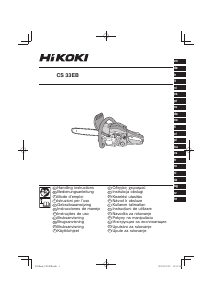
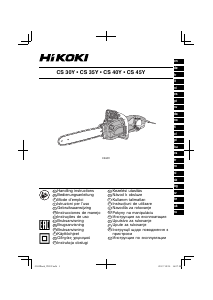
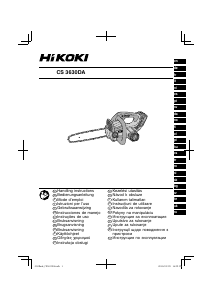


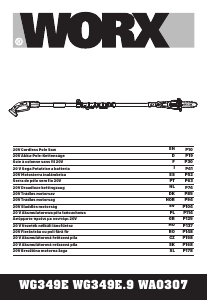
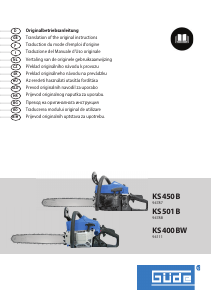
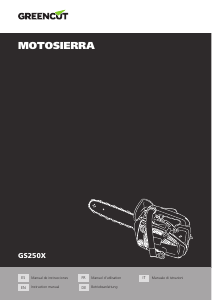
Partecipa alla conversazione su questo prodotto
Qui puoi condividere cosa pensi di Hikoki CS 30SB Motosega. Se hai una domanda, leggi prima attentamente il manuale. La richiesta di un manuale può essere effettuata utilizzando il nostro modulo di contatto.